- Clinical Technology
- Adult Immunization
- Hepatology
- Pediatric Immunization
- Screening
- Psychiatry
- Allergy
- Women's Health
- Cardiology
- Pediatrics
- Dermatology
- Endocrinology
- Pain Management
- Gastroenterology
- Infectious Disease
- Obesity Medicine
- Rheumatology
- Nephrology
- Neurology
- Pulmonology
Decision Making Regarding Prescription Drugs: Out-of-Pocket Pressures
Dr Schommer is professor, University of Minnesota College of Pharmacy, Minneapolis. Cindy Chen, Jagannath Muzumdar and Siting Zhou are doctoral candidates at the University of Minnesota College of Pharmacy.
Insurance coverage for prescription drugs makes a difference in the amount of medications people obtain, how much they spend on medications out-of-pocket, and how much is spent in total on their behalf.1 Persons with insurance coverage also are more likely to have access to a broader array of therapies, including more costly therapies.2 Those without prescription drug coverage face greater financial burdens and may sometimes be unable to follow the courses of treatment prescribed for them.1,2
An April 2008 survey showed that uninsured nonelderly adults (18 to 64 years of age) were more than twice as likely as insured nonelderly adults to report that they or a family member did not fill a prescription (45% vs 22%) or that they cut pills or skipped doses of medicine (38% vs 18%) in the past year because of the cost.3 A survey of Americans 65 years and older that controlled statistically for prescription drug use and income showed that respondents without any prescription insurance coverage were 5 times more likely to report financial hardship than those with coverage.1 For the subset of respondents with prescription insurance coverage, number of prescriptions used daily and income were associated with reporting financial hardship.1

Although prescription drug spending has been a smaller proportion of total national health care spending (10% in 2006) compared with hospital services (31%) and physician services (21%),4 it was one of the fastest-growing health expenditures between 1997 and 2002. To help improve access to prescription medications, the share of prescription drug expenses paid by third parties, such as private health insurance and public funds, continued to grow between 2003 and 2008, leaving a smaller proportion to be paid out-of-pocket by consumers (out-of-pocket payments were 26% of total expenditures in 2003 compared with 20% in 2008). Figure 1 summarizes prescription drug expenditures by source of funds for 2003 to 2011 (projected). It should be noted that 2006 was the year Medicare Part D coverage for prescription medications took effect.
As prescription medications became more commonly paid for by a third party, incentive-based formularies were an innovation designed to curb the increasing costs of prescription drugs for third-party payers. Incentive-based formularies provide financial incentives such as lower copayments for enrollees for medications that are preferred by the payer (typically lower-cost alternatives), but higher copayments, or no coverage at all, for nonpreferred medications.
Research showed that the adoption of an incentive-based formulary resulted in lower aggregate utilization of and spending for prescription medications.5,6 However, evidence suggests that increased cost sharing for prescription medications also is associated with delayed initiation of drug therapy for patients with a newly diagnosed chronic disease,7 worse adherence to medication regimens,8 more frequent discontinuation of therapy,8,9 and decreased overall drug use for life-sustaining drugs.10 One study showed that reductions in prescription drug spending achieved through tiered copayment formularies largely benefited health insurance plans because the percentage of drug expenses that beneficiaries paid out-of-pocket rose significantly.11
Brennan and Reisman12 pointed out that “the copayment brings the patient’s judgment to bear on the question of whether a prescribed medication is really efficacious and necessary, thereby countering moral hazard. Underlying this are two assumptions: that medications prescribed by doctors can range from those that are very useful to those that are not so useful; and that patients will be able to discriminate.”
At the time of our study, access to prescription drugs had been improved through broader prescription drug insurance coverage. However, some prescription drugs still could be prohibitively expensive for certain patients, even if they had insurance coverage for them. Navigating patients’ prescription drug options in light of related costs can be difficult because of a lack of information on the parts of both prescribers and their patients.13 For example, Shrank and colleagues14 reported that many prescribers of medications are not aware of patients’ formularies or out-of-pocket costs for medications, do not feel responsible for managing these costs, and prefer that a pharmacist address these matters.
Typically, patients are unaware of the cost consequences regarding prescribing decisions during their clinical encounter and rarely talk with their physicians about costs of prescription drugs.15,16 Patients often do not become aware of their out-of-pocket costs for prescription medications until the medication is dispensed by a pharmacist. Prescription medications that are deemed too costly by patients are more likely to be discontinued or used at sub- optimal doses than prescription medications that are deemed to be worth the cost.17,18
The focus of our research was to better understand prescription drug decision making during clinical encounters, prescription procurement, and prescription use. Decisions at each of these stages can affect which prescription medications are used by patients and how they are used.
Overall Study Goals
To learn more about the prescription choice process from several informed viewpoints, we set our overall goal to uncover and describe how consumers, prescribers, pharmacists, and social workers view prescription choice processes, not only during clinical encounters but also during prescription procurement and prescription use. We began our investigation with a focus on (1) topics of importance for patients on receiving a prescription for a medication, (2) first impressions once a medication was started, (3) the nature of interactions between prescribers and patients, (4) the desired level of patient involvement regarding prescription medication choices, (5) communication strategies that are used by patients after a prescribing decision was made, and (6) the relative importance of out-of-pocket costs compared with total cost of prescription medications.
Such a description of the prescription choice process from several viewpoints would provide insight for developing strategies for incorporating not only effectiveness and safety information but also cost information into medication-use decisions. Preliminary findings regarding these areas of focus have been presented elsewhere.19-23 The purpose of this article is to present findings related to the relative importance of out-of-pocket costs compared with total cost of prescription medications within the context of decision making about prescription drugs.
Objectives for This Article
The first objective is to describe and compare the opinions of consumers, physicians, pharmacists, and social workers concerning the relative importance of out-of-pocket costs compared with total cost of prescription medications for patients. The second objective is to compare estimates made by consumers, physicians, pharmacists, and social workers regarding the extent to which purchasing prescription drugs causes patients to experience financial hardship.
Methods Study design and data collection. A cross-sectional descriptive survey design was used for collecting data. On the basis of findings from previously conducted focus groups,23 a questionnaire consisting of 7 open-ended questions about respondents’ views regarding how consumers make decisions about using prescription drugs was developed. The 7 questions were:
1. Just to get started, please think back to the time when you were prescribed a medication. For example, what kinds of questions did you have about the medicine’s effectiveness, safety, or cost? Did you ask anyone these questions? Or, did you accept the advice given to you at the time? After you started using the medicine, did you ask people questions about it? What were they? In the space below, please write down some words or thoughts that come to mind. You may simply jot down words or short phrases. If you have never received a prescription for a medication, please leave the space blank.
2. Next, please think about the medications you are currently taking. What were your first impressions of the medicines when you started to use them? Again, you may jot down words or short phrases if you wish. If you are not using any medications, please leave the space blank.
3. What are some words that best describe your interaction with your doctor as you talk about medications? For example, what do you talk about? How do you communicate with each other? How do you make decisions about which medicine is best for you? What do you like? What don’t you like? If you have never had an interaction with a doctor, please leave the space blank.
4. Describe the level of involvement you would like to have in making decisions about the prescription medications that are prescribed for you.
5. When you talk with others about your medications, what do you talk about and with whom do you talk the most?
6. Do you prefer to seek information about new medicines on your own or do you prefer to get help from another person? Who would that person be? If on your own, what sources do you use?
7. What is more important to you: (a) what you pay for a prescription or (b) the total cost of a prescription (what you pay + what your insurance or other program pays)? Please explain your answer.
Each question was worded so that it would be applicable to each type of survey respondent. For example, Question 7 was the item applicable for this article and was worded for each respondent type as follows:
Consumer survey: 7. What is more important to you: (a) what you pay for a prescription or (b) the total cost of a prescription (what you pay + what your insurance or other program pays)? Please explain your answer.
Physician survey: 7. What is more important to your patients: (a) what they pay for a prescription or (b) the total cost of a prescription (what they pay + what their insurance or other program pays)? Please explain your answer.
Pharmacist survey: 7. What is more important to your patients: (a) what they pay for a prescription or (b) the total cost of a prescription (what they pay + what their insurance or other program pays)? Please explain your answer.
Social worker survey: 7. What is more important to your clients: (a) what they pay for a prescription or (b) the total cost of a prescription (what they pay + what their insurance or other program pays)? Please explain your answer.
We also collected demographic information about respondents to help analyze the findings. One demographic question asked each respondent about the extent to which purchasing prescription drugs causes financial hardship for patients. Consumer respondents were asked to respond yes or no to the question to reflect their personal experiences. Other respondents were asked to report “what proportion of their patients/clients they believed experience financial hardship” (0% to 100%).
Randomly selected samples of 400 consumers (ie, adult population), 400 physicians, 400 pharmacists, and 400 social workers residing in Minnesota were used. Simple random samples of persons in each respondent category were obtained from KM Lists, Inc, which compiles a complete listing for the United States from publicly available sources, including telephone directories, drivers’ license databases, and other public records. KM Lists, Inc, continually updates its lists and tests them for validity. Data were collected via a mailed survey method during the summer of 2008, following principles outlined by Dillman.24
A prenotification letter was mailed to each sample member informing him or her that a survey would be forthcoming and that a small token of appreciation would be included in that package. One week later, a cover letter accompanied each survey explaining the purpose of the study, ensuring confidentiality of responses, and asking for the individual’s participation. A solar-powered calculator and a postage-paid return envelope were included with the surveys to facilitate response.24 Three weeks after each survey was mailed, another survey form was mailed to each nonresponder to remind him to return his completed form.
Data analysis. Responses to the 7 open-ended questions were analyzed using content analysis following procedures recommended by Kassarjian25 and Kolbe and Burnett.26 After developing rules for coding the responses, 2 judges were recruited to do the coding. The judges were trained on the rules and proce- dures for coding and independently scored 106 responses for the 7 open- ended questions. Interjudge reliabilities were calculated by using the Perreault and Leigh27 reliability index as follows:
I = {[(F/N) 2 (1/k)][k/(k21)]}½
Where F = the observed frequency of agreement between the judges, N = the total number of judgments, and k = the number of categories.
The 2 judges had a high level of agreement in their scoring (interjudge reliability scores ranged from 0.93 to 0.99). In light of reliability scores well above the recommended level of 0.90, one researcher completed the rest of the coding for this study.
Descriptive statistics were used for describing respondents and their distribution of answers to the open-ended questions. Chi-square analysis was used for making comparisons among groups of respondents. A significance level of 0.05 was used for all statistical tests and computed using SPSS 16.0 statistical software. Missing data, “not applicable” responses, and “don’t know” responses were identified, and procedures for handling these data were implemented depending on the extent of missing data for each variable.
To help interpret study findings, verbatim written answers were selected and reported for this article. These written responses provide information given in the respondents’ own words and provide insight for understanding the results.
Results
Of 400 surveys mailed to consumers, 333 were deliverable to the addressee. Of those deliverable, 107 (32%) were returned. Of 400 surveys mailed to physicians, 384 were deliverable to the addressee. Of those deliverable, 136 (35%) were returned. Of 400 surveys mailed to pharmacists, 396 were deliverable to the addressee. Of those deliverable, 168 (42%) were returned. Of 400 surveys mailed to social workers, 375 were deliverable to the addressee. Of those deliverable, 178 (48%) were returned.
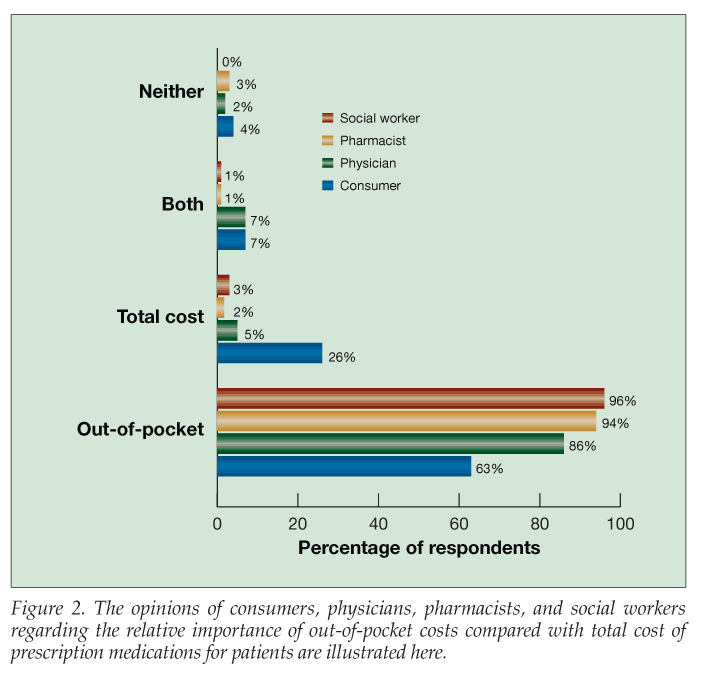
Objective 1. To describe and compare the opinions of consumers, physicians, pharmacists, and social workers about the relative importance of out-of-pocket costs compared with total cost of prescription medications for patients. Figure 2 shows that most of the 4 respondent types reported that out-of-pocket costs are most important to patients, compared with total cost of prescription medications. However, a higher proportion of consumers (26%) reported that total cost was most important compared with the proportions of physicians (5%), pharmacists (2%), and social workers (3%), who reported that total cost was most important.
None of the demographic variables we collected for consumers (age; sex; education; experiencing financial hardship resulting from prescription drug costs; or hours spent watching television, listening to radio, or reading newspapers/magazines) were useful for discriminating between those who reported “total cost” compared with other response options. However, written responses provided insight into why respondents reported total cost as being most important to them (Table 1 in “Selected Written Answers by Consumers, Physicians, Pharmacists, and Social Workers”).
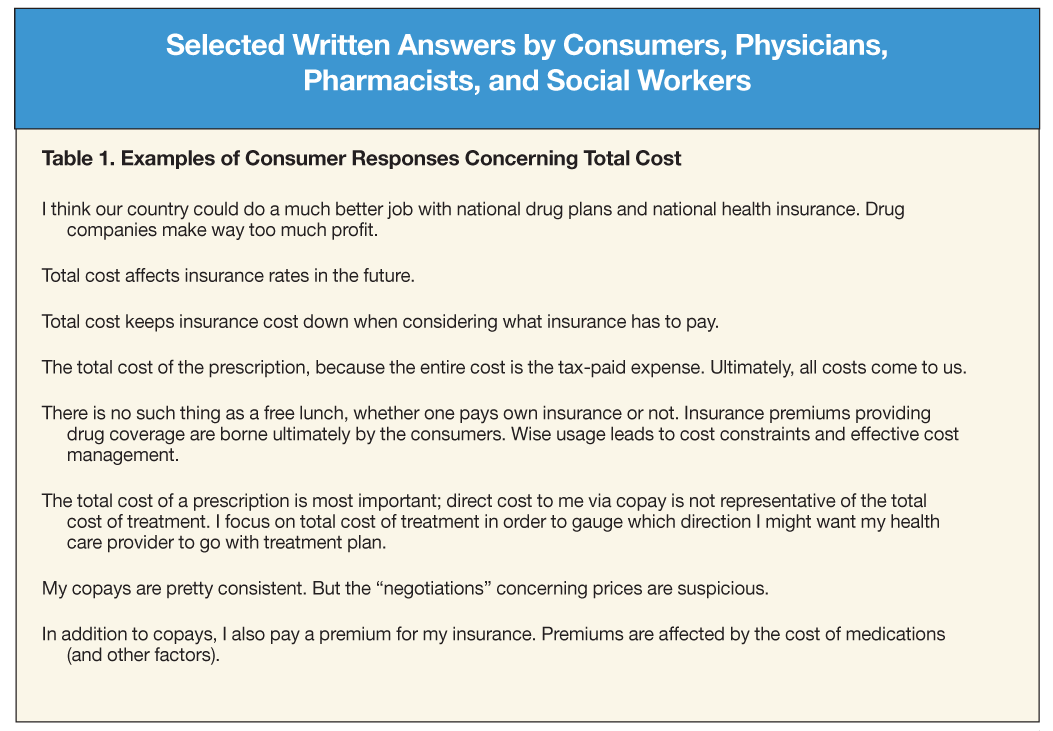
also shows that consumer and physician respondents were more likely to report that both types of costs were important to patients (7% for both) compared with pharmacists and social workers (1% for both). To investigate this difference further, we hypothesized that older consumers may place importance on both out-of-pocket and total costs because of the recent Medicare Part D coverage for prescription drugs and because of the “donut hole,” which is computed based on total cost. Further analysis for the consumer group showed that those 65 years and older were more likely to report that both out-of-pocket and total costs were most important (15%) than were those 64 years and younger (3%).
Physicians who reported that their patients deemed both out-of-pocket and total costs as most important saw fewer patients per day (9 vs 18 patients), prescribed fewer medications per day (9 vs 20 prescriptions), were older (56 years vs 51 years), and reported a higher proportion of their patients to be experiencing financial hardship (43% vs 31%).
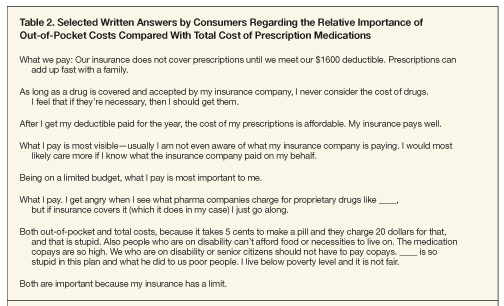
To provide further insight into the findings for objective 1, verbatim written responses are provided in Tables 2, 3ab, 4ab, and 5 in “Selected Written Answers by Consumers, Physicians, Pharmacists, and Social Workers.”
Objective 2. To compare estimates made by consumers, physicians, pharmacists, and social workers regarding the extent to which purchasing prescription drugs causes patients to experience financial hardship.

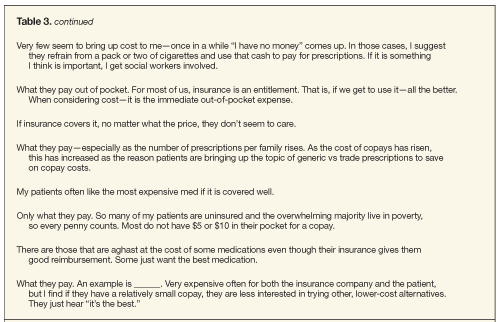
Figure 3 shows that 27% of consumers reported that purchasing prescription drugs causes them to experience financial hardship. Twenty-two percent of respondents younger than 65 years reported financial hardship, compared with 38% of responders 65 years and older (P = .11, nonsignificant difference). We consider the 2008 estimate to be similar to the one reported by Schommer and colleagues1,28 (31%) from data collected in 2001 via consumer surveys of Americans 65 years and older.

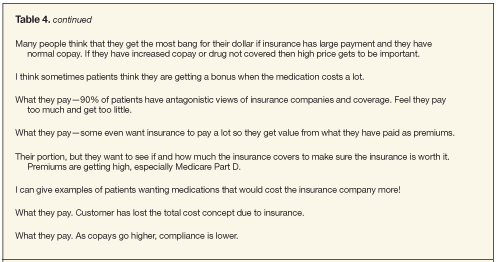
Figure 3 also shows that physicians’ estimates of financial hardship for patients (31% of their patients) were similar to what consumers reported. The estimate of 21% made by pharmacists was lower but not statistically different. The relative- ly higher estimate of 42% made by social workers (P = .05, statistically significant) probably reflects their client base.
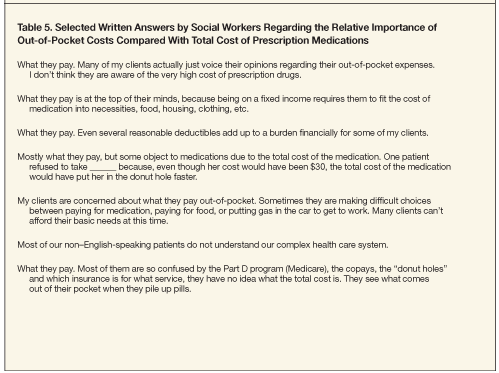
Further analysis for the consumer group showed that 84% of respondents reporting financial hardship were women compared with only 41% of the respondents in the group that did not report financial hardship.
To provide further insight into these findings, verbatim written responses are provided in Table 6 in “Selected Written Answers by Consumers, Physicians, Pharmacists, and Social Workers.”
Discussion
The findings suggest that physicians, pharmacists, and social workers underestimate the proportion of consumers who consider total cost of prescriptions to be most important (26%). There appears to be a segment of the health care consumer population that considers prescription drug costs within a larger context that may include insurance premiums, taxes, and costs of other health care services.

Another segment we identified was a group of consumer respondents who considered both out-of-pocket and total costs of prescriptions. This probably reflects persons covered by Medicare Part D and the donut hole element of that type of prescription drug coverage. However, the vast majority of consumer respondents reportedly deem out-of-pocket costs as most important. On the basis of written comments, there is evidence that out-of-pocket costs for prescription drugs can become a financial hardship and affect decisions regarding the use of prescription drugs.
The findings also revealed that in 2008, the proportion of consumers who reported that purchasing prescription drugs causes them to experience financial hardship (27%) was similar to estimates made by physicians and pharmacists, which suggests that they are aware of their patients’ financial hardships. Social workers reported a somewhat higher estimate for the extent of financial hardship for their clients (42%), which probably reflects their client base accurately.
On the basis of these findings, we propose that cost sharing that is part of incentive-based formularies can become a hardship for consumers as they compute the total monthly cost of copayments for all of the medications that they are taking and compare that total with their monthly household budget. Incentive-based formularies are typically developed with a focus on one drug product class at a time. Little or no consideration for such formulary programs is given to consumers who require multiple drug products or to how out-of-pocket costs for the patient in toto affect patient decisions and outcomes.
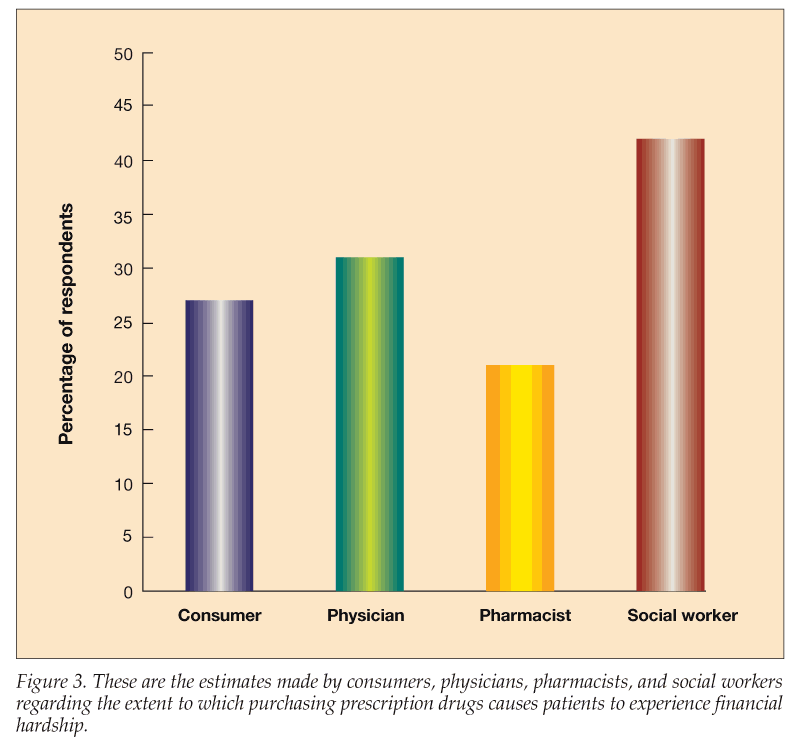
There are 2 relatively new services known to the authors that may help with this challenge. One is medication therapy management, which was incorporated into the Medi- care Part D prescription drug program so that therapeutic outcomes would be optimized through improved medication use and through reduced risk of adverse events.29 During approximately the same period, state-based Medicaid programs and self-insured employer groups used similar approaches and focused on improving medication therapy outcomes. A service focused on all of a patient’s drug therapy needs, including affordability, is an important next step for addressing the challenges outlined in this article.
The other service has been developed by the nonprofit organization Consumers Union. It developed the Consumer Reports Best Buy Drugs program, which is an evidence-based tool for consumer and prescriber education. This tool is a resource for comparing relative safety, effectiveness, and cost within product classes to help identify products that provide the best value.30 However, use of this tool can be inhibited by formulary restrictions that may be guided by other priorities, such as rebates, pay-for-performance, out-of-pocket cost differentials, advertising, and government regulations at the various stages of prescription choice.31
In addition, prescription drug plans that contain deductibles, donut holes, and annual limits for coverage can result in consumers considering not only how monthly copayments affect their personal budgets but also how total cost of medications they are taking will affect their coverage and out-of-pocket responsibilities throughout the year.
We propose that it would be helpful for future work related to understanding how to balance “equal treatment” and “fair treatment” in prescription drug decision making to focus on value-based insurance design. Brennan and Reisman12 have suggested that this can be accomplished by integrating financial incentives into benefit design, building advice about evidence-based treatment into the plans, and using information technology in these efforts. We would add that value-based prescription drug insurance design should also consider out-of-pocket and total costs of prescription drug therapy for all of the medications a person is taking. Health consumers do not make health decisions based on one prescription drug product at a time in isolation. Rather, our findings suggest that they make decisions based on the whole bundle of medications they are using within the larger context of their overall lives.
Limitations. The study results, and our interpretation of them, should be tempered by the limitations of the study. The results are based on self-reports, raising questions about the extent to which respondents gave socially desirable responses. Nonresponse bias is another limitation. It is possible that responders were more interested in the topic we studied or had stronger opinions about the questions we asked than those who chose not to respond. The sampling frame and mailing addresses for this study were obtained from a company that maintains commercial mailing lists. Their database is updated from public sources such as telephone directories and drivers’ license databases. However, by the time we mailed our surveys, it is likely that some members of our sample were deceased, were physically or mentally no longer able to complete the survey, or were no longer at the address. For this study, the proportion of undeliverable surveys for the consumer group was relatively high compared with the other 3 respondent groups.
Finally, the relatively low response rate for consumers compared with the other responder types (phy- sicians, pharmacist, and social workers) surprised us. Typically, consumers are more likely to respond to opinion surveys than professionals. We believe that the open-ended questions that were used in our survey were burdensome to consumer respondents. Conversely, some professionals who responded wrote that they appreciated the open-ended for- mat of our survey so that they could more fully express their opinions.
Conclusions. We conclude that while most consumers focus only on their out-of-pocket costs for prescription drugs and do not report financial hardship from purchasing prescription drugs, at least 1 of 4 consumers (26%) focuses on total cost and at least 1 of 4 consumers (27%) experiences financial hardship from purchasing prescription drugs. However, there was not a significant relationship between a focus on total costs and financial hardship.
We suggest that multiple segments of the health care consumer market focus on different types of cost information when making de- cisions about prescription drug therapy. Although increasing insur- ance coverage for prescription drugs can improve individuals’ access to medications, out-of-pocket expens- es in addition to premiums can be burdensome to certain groups of consumers.
References:
References
1. Schommer JC, Mott DA, Hansen RA, Cline RR. Selected characteristics of senior citizens prescription drug payment and procurement in 1998 and 2001. J Manag Care Pharm. 2003;9:408-415.
2. US Department of Health and Human Services. Report to the President on Prescription Drug Coverage, Spending, Utilization, and Prices. Washington, DC: US Dept of Health and Human Services; 2000.
3. Kaiser Family Foundation. Kaiser Public Opinion Survey Brief. Economic Problems Facing Families. April 2008:4. http://www.kff.org/kaiserpolls/ upload/7773.pdf. Accessed September 25, 2009.
4. Lundy J; Kaiser Family Foundation. Prescrip-tion drug trends. September 2008. Menlo Park, Calif. http://www.kff.org/rxdrugs/upload/ 3057_07.pdf. Accessed September 25, 2009.
5. Motheral B, Fairman KA. Effect of a three-tier prescription copay on pharmaceutical and other medical utilization. Med Care. 2001;39:1293-1304.
6. Huskamp HA, Deverka PA, Epstein AM, et al. The effect of incentive-based formularies on prescription-drug utilization and spending. N Engl J Med. 2003;349:2224-2232.
7. Solomon MD, Goldman DP, Joyce GF, Escarce JJ. Cost sharing and the initiation of drug therapy for the chronically ill. Arch Intern Med. 2009; 169:740-749.
8. Goldman DP, Joyce GF, Zheng Y. Prescription drug cost sharing: associations with medication and medical utilization and spending and health. JAMA. 2007;298:61-69.
9. Gleason PP, Gunderson BW, Gericke KR. Are incentive-based formularies inversely associated with drug utilization in managed care? Ann Pharmacother. 2005;39:339-345.
10. Austvoll-Dahlgren A, Aaserud M, Vist G, et al. Pharmaceutical policies: effects of cap and co-payment on rational drug use (Cochrane Review). In: The Cochrane Library, Issue 1, 2008. http://www.thecochranelibrary.com. Accessed September 25, 2009.
11. Joyce GF, Escarce JJ, Solomon MD, Goldman DP. Employer drug benefit plans and spending on prescription drugs [published correction appears in JAMA. 2002;288:2409]. JAMA. 2002; 288: 1733-1739.
12. Brennan T, Reisman L. Value-based insurance design and the next generation of consumer-driven health care. Health Aff (Millwood). 2007; 26:W204-W207.
13. Kohl H, Shrank WH. Increasing generic drug use in Medicare Part D: the role of government. J Am Geriatr Soc. 2007;55:1106-1109.
14. Shrank WH, Young HN, Ettner SL, et al. Do the incentives in 3-tier pharmaceutical benefit plans operate as intended? Results from a physician leadership survey [published correction appears in Am J Manag Care. 2005;11:180]. Am J Manag Care. 2005;11:16-22.
15. Shrank WH, Fox SA, Kirk A, et al. The effect of pharmacy benefit design on patient-physician communication about costs. J Gen Intern Med. 2006;21:334-339.
16. Alexander GC, Casalino LP, Meltzer DO. Patient-physician communication about out-of-pocket costs. JAMA. 2003;290:953-958.
17. Shrank WH, Hoang T, Ettner SL, et al. The implications of choice: prescribing generic or preferred formulary medications improves adherence to chronic medications. Arch Intern Med. 2006;166:332-337.
18. Taira DA, Wong KS, Frech-Tamas F, Chung RS. Copayment level and compliance with anti- hypertensive medication: analysis and policy implications for managed care. Am J Manag Care. 2006;12:678-683.
19. Muzumdar J, Schommer JC, Chen Y-W, et al. Decision-making regarding prescription drugs: first impressions. Presented at: 156th Annual Meeting of the American Pharmacists Association; April 3-6, 2009; San Antonio, Tex.
20. Chen Y-W, Zhou S, Schommer JC, et al. Decision-making regarding prescription drugs: getting involved. Presented at: 156th Annual Meeting of the American Pharmacists Association; April 3-6, 2009; San Antonio, Tex.
21. Kjos AL, Schommer JC, Worley MM, et al. Decision-making regarding prescription drugs: social networking. Presented at: 156th Annual Meeting of the American Pharmacists Association; April 3-6, 2009; San Antonio, Tex.
22. Schommer JC, Chen Y-W, Kjos AL, et al. Decision-making regarding prescription drugs: out-of-pocket pressures. Presented at: 156th Annual Meeting of the American Pharmacists Association; April 3-6, 2009; San Antonio, Tex.
23. Schommer JC, Worley MM, Kjos AL, et al. A thematic analysis for how patients, prescribers, experts, and patient advocates view the prescription choice process. Res Social Adm Pharm. 2009; 5:154-169.
24. Dillman DA. Mail and Internet Surveys-The Tailored Design Method. 2nd ed. New York: John Wiley & Sons; 2000.
25. Kassarjian HH. Content analysis in consumer research. J Consumer Res. 1977;4(June):8-18.
26. Kolbe RN, Burnett MS. Content-analysis research: an examination of applications with directives for improving research reliability and objectivity. J Consumer Res. 1991;18(Sept):243-250.
27. Perreault WD, Leigh LW. Reliability of nominal data based on qualitative judgments. J Marketing Res. 1989;26(May):135-148.
28. Schommer JC, Mott DA, Hansen RA, Cline RR. Prescription drug insurance coverage for older Americans: 1998-2001. Presented at: American Association of Pharmaceutical Scientists Annual Meeting; November 11, 2002; Toronto.
29. Smith SR, Clancy CM. Medication therapy management programs: forming a new cornerstone for quality and safety in Medicare. Am J Med Qual. 2006;21:276-279.
30. Schommer JC, Worley MM, Schondelmeyer SW, et al. Evaluation of Best Buy Drug Outreach Project. Presented at: 156th Annual Meeting of the American Pharmacists Association; April 3-6, 2009; San Antonio, Tex.
31. Schondelmeyer SW, Kjos AL, Yuan Y, Schommer JC. Cost savings to a health plan from evidence-based utilization of prescription drugs. Presented at: 156th Annual Meeting of the American Pharmacists Association; April 3-6, 2009; San Antonio, Tex.
32. National Health Expenditure forecast summary from Centers for Medicare & Medicaid Services. http://www.cms.hhs.gov/NationalHealth ExpendData. Accessed September 25, 2009.
